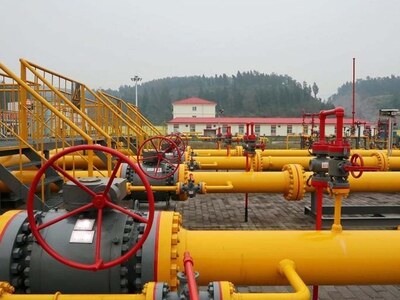Russia to Boost Gas Supply to China, Power of Siberia 2 Pipeline Still Faces Pricing Hurdles
Moscow has reached an agreement to augment its natural gas exports to China and formalized a memorandum concerning the construction of the expansive Power of Siberia 2 pipeline. However, pricing details for this significant gas infrastructure project remain unresolved, according to a statement released by Gazprom on Tuesday.
The partnership between China, a major energy consumer, and Russia, a substantial producer of natural resources, has grown stronger since Western nations imposed sanctions on Russia in response to the conflict in Ukraine. Chinese President Xi Jinping’s deepened ties with Russian President Vladimir Putin indicate a resistance to U.S. calls to distance from Moscow.
The outstanding pricing agreement for the Power of Siberia 2 suggests that China is seeking considerable cost reductions from Russia.
With the decline in its access to the European gas market, Russia has increasingly focused on China. Gazprom has been pursuing the Power of Siberia 2 pipeline project for several years. This pipeline aims to deliver 50 billion cubic meters (bcm) of gas annually to China from the Yamal Arctic gas fields, transiting through Mongolia.
Gazprom CEO Alexei Miller stated that a consensus was achieved to increase gas deliveries via the existing Power of Siberia pipeline, which extends from Eastern Siberia to China, from 38 bcm to 44 bcm annually.
“A legally binding memorandum was signed for the construction of the Power of Siberia 2 gas pipeline and the Soyuz Vostok transit gas pipeline through Mongolia,” Miller announced. Soyuz Vostok is planned as the segment of the Power of Siberia 2 pipeline that will cross Mongolia.
Gas Price Lower Than Europe
The cost of gas delivered through the pipeline, an important determinant of overall project expenses and their distribution among stakeholders, will be determined independently, according to TASS news agency citing Miller.
Miller indicated that the price would be less than what Gazprom charges European customers, attributable to the substantial distances and challenging terrain involved in pipeline construction.
The entity responsible for building the pipeline remains unspecified. Following a meeting between Putin, Xi, and Mongolian President Ukhnaagiin Khurelsukh in Beijing, the Kremlin reported the signing of 22 agreements during discussions with China, including a strategic cooperation agreement between Gazprom and China National Petroleum Corporation, but specific details were not disclosed.
Constructing a gas pipeline from the extensive Bovanenkovo and Kharasavey gas fields in northern Russia, across Siberia to Mongolia and onward to China, would represent a substantial and capital-intensive gas undertaking, Miller commented.
Previously, it was reported that China intended to acquire more Russian gas through an existing pipeline due to slow advancements in negotiations for the construction of a new connection.
New Era
Both Putin and Xi assert that the global landscape is undergoing a transformation, with the influence of the West diminishing. They point to the perceived injustices stemming from the dissolution of the Soviet Union in 1991 and centuries of European colonial dominance in China.
Kirill Babaev, who is the head of the China and Contemporary Asia Institute in Moscow, an advisory body to the Russian government on matters concerning China, stated that the gatherings in Beijing demonstrated the failure of Western attempts to isolate Russia.
He emphasized that the leaders of Russia, China, and Mongolia have given their political support to the pipeline project, despite some uncertainties that remain.
China is identified as Russia’s largest trade partner, the primary buyer of Russian crude oil and gas, the second-largest purchaser of Russian coal, and the third-largest acquirer of Russian LNG, as indicated by the Kremlin. Gazprom delivers natural gas to China via the 3,000 km Power of Siberia pipeline, under a 30-year agreement valued at USD400 billion, initiated in 2019. Deliveries are projected to reach the agreed capacity of 38 bcm this year.
Miller also mentioned an agreement to raise China’s gas imports via a pipeline from Sakhalin Island in Russia’s Far East to 12 bcm annually, up from the previously agreed 10 bcm.
However, Russia’s gas exports to China remain a relatively modest portion of the 177 bcm it supplied to Europe annually during 2018-19.



Comments (0)
No comments yet. Be the first to comment!
Leave a Comment